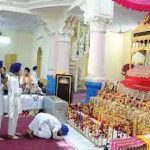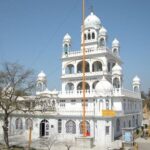Gurus are fundamental to Sikh belief. Eleanor Nesbitt examines Guru Nanak, the notion of Guru in Sikhism, the essential principles of Gurus’ teachings, and the sacred scripture, the Guru Granth Sahib. There are around 24 million Sikhs worldwide today. The majority of them reside in the Indian state of Punjab. They consider Guru Nanak (1469-1539) to be the faith’s founder, and Guru Gobind Singh (1666-1708), the tenth Guru, to be the Guru who formalized their religion. Religions and religious leaders do not exist in a vacuum: during the Gurus’ time, India was ruled by Muslim Mughal monarchs. The Punjabi people were a combination of Muslims and Hindus.
The Sikh faith has evolved from the Gurus’ teachings and the devotion of their followers into a world religion with its scripture, code of discipline, gurdwaras (places of worship), festivals, and life cycle rites, and Sikhs share a strong sense of identity and celebrate their unique heritage.
The importance of blending spirituality with carrying out one’s responsibilities is a major principle of the Gurus’ teaching. Sikhs should practice simaran when performing seva (volunteer service to others) (remembrance of God). A sant sipahi (warrior saint) is someone who blends spiritual traits with a willingness to take daring action. Guru Nanak, the first Guru, and Guru Gobind Singh, the tenth Guru, are still revered by Sikhs.
What was Guru Nanak’s name?
Guru Nanak was born in 1469 in Talvandi, now known as Nankana Sahib in the Pakistani province of Punjab. His parents were Hindus of the Khatri caste, which meant they had a family accounting heritage. The name ‘Nanak,’ like Nanaki, his sister’s name, may signify that they were born in their mother’s parents’ home, known as their Nanak in Punjabi. Guru Nanak’s wife’s name was Sulakhani, and she had two sons. Nanak worked as a storekeeper for the local Muslim governor before having a life-changing religious encounter. When he was approximately thirty years old, he was swept into God’s presence while taking his usual bath in the river. As a result, he gave away his belongings and began his life’s mission of sharing his spiritual discoveries. This he accomplished by writing poetry poems that he performed to the accompaniment of a rabab, the stringed instrument played by his Muslim traveling companion, Mardana. After a long travel, Guru Nanak resided at Kartarpur (‘Creator Town,’ forming a community of disciples (Sikhs) around him.
Guru Nanak’s poetry (or shabads) in the Guru Granth Sahib (scripture) provides a strong sense of his awareness of a single supreme reality (ik oankar) at the root of all phenomena in the world. His shabads emphasize the significance of integrity over outward religious displays, as well as being conscious of God’s name (nam) and being kind to others through dan (pronounced like the English word ‘darn,’ i.e. giving to others. His poetry is full of word pictures of animals and birds, as well as human activities like farming and trade.
The British Library has lithographs and manuscripts of well-known Guru Nanak stories, including the Vilaitvali Janam-Sakhi and the more famous, wonderfully drawn B40 Janam-Sakhi. (The words ‘Janam’ and Sakhi denote birth and testament, respectively.) Even though Guru Nanak and his successors condemned miracles, some of the incidents detailed in the Janam-Sakhi are miracles. The stories are intended to praise the Guru; anecdotes frequently carry a deeper meaning, such as when Nanak asked a rich man to take a needle to heaven for him, demonstrating the futility of collecting wealth.
Guru Nanak’s significance stems not only from his inspirational teaching but also from the practical foundation he laid for a new religious movement: he founded a community of his followers in Kartarpur and designated a successor, Guru Angad, based on his loyal service. Guru Nanak is revered as ‘Baba Nanak’ by Punjabi Muslims, Sikhs, and Punjabi Hindus alike.
Sikhs commemorate his birthday every year on the full moon in November. It is distinguished, like other gurpurabs (festivals remembering a Guru), by an Akhand path (pronounced like ‘part’), a 48-hour continuous, entire reading of the Guru Granth Sahib that concludes on the festival morning. In 2019, commemorative events marked the 550th anniversary of Guru Nanak’s birth.
What is the Sikhism notion of Guru?
Nanak was initially referred to as ‘Baba Nanak,’ with ‘Baba’ being a loving name, similar to ‘grandfather,’ for an older man. He is now better known as Guru Nanak. ‘Guru’ means instructor in the same way that ‘Sikh’ means learner. ‘Guru’ means remover of darkness,’ according to Sikhs. The Gurmukhi script used for the Punjabi language has no capital letters, however, in English, a capital ‘G’ for Guru in the Sikh sense is proper. There have only been ten human Gurus. Their lives spanned the years from Nanak’s birth in 1469 to Guru Gobind Singh’s death in 1708. The Guru Granth Sahib, the precious volume of text, has been the Sikhs’ living Guru since then. The Guru Granth Sahib is more than just a book: it is said to embody the Guru and to contain compositions by six of the ten Gurus. God, also known as ‘Satguru’ (the genuine Guru) and ‘Waheguru,’ is the supreme Guru (Nanak’s Guru) (a name that began as an exclamation of praise).








